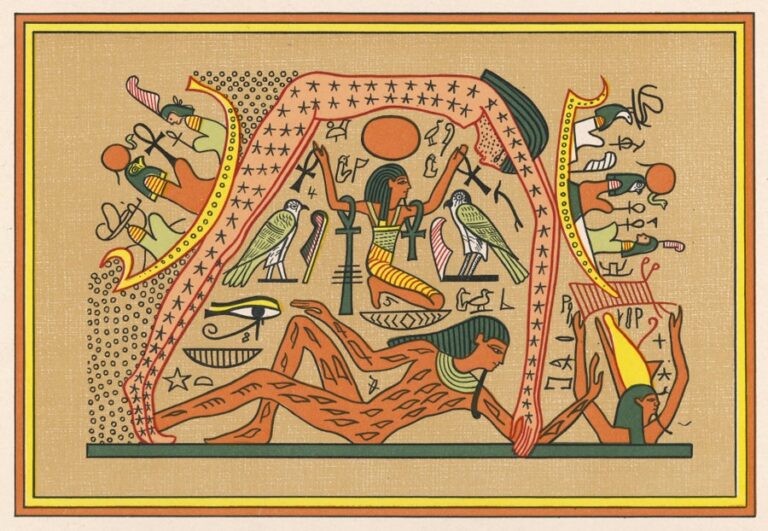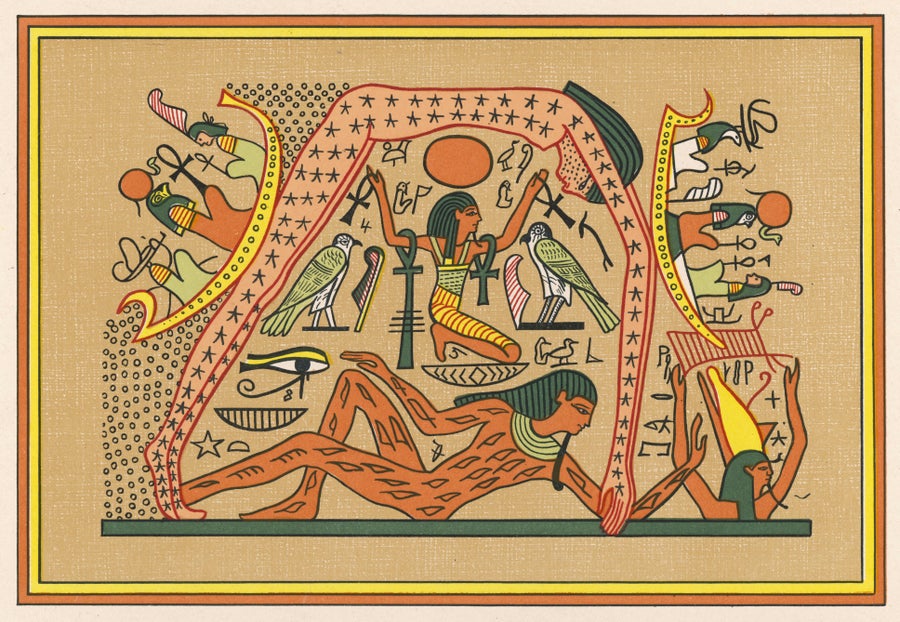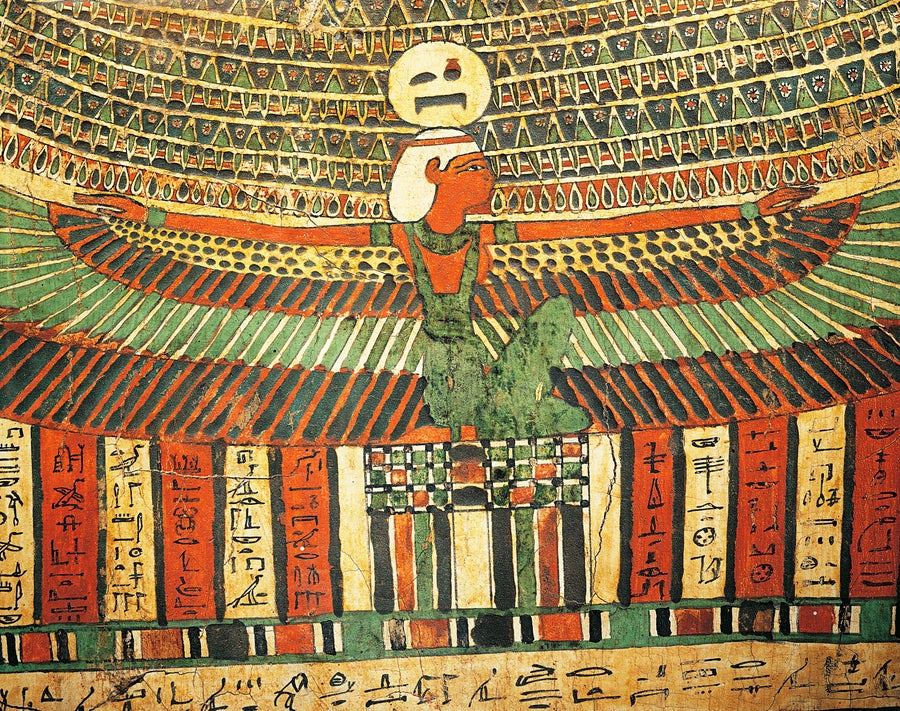
[ad_1]
The broad band of opalescent light and dark shadow that crosses the night sky has long fascinated humanity. Today it is known, variously, as the Milky Way, the Silver River, the Birds’ Path. We see it as the celestial counterpart of major rivers, a path for departed spirits, the birthplace of angels. But how the ancient Egyptians—who left us some of the earliest records of the heavens—viewed the Milky Way has remained a mystery. Recently, I discovered some tantalizing clues that suggest a possible link between an ancient Egyptian goddess and our home galaxy.
The ancient Egyptians were keen observers of the night sky. They worked their astronomical observations into their religion, mythology and timekeeping (they invented such concepts as 365-day years and 24-hour days). The sun was the most important celestial object and was personified by the most important gods (chief among them Re). Scholars have identified the moon, planets and certain stars and constellations in Egyptian texts and tomb murals, some of which date back all the way to the age of the pyramids more than 4,000 years ago. The Milky Way, however, has not been identified conclusively.

The sky goddess Nut, covered in stars, is held aloft by her father, Shu, and is arched over Geb, her brother the Earth god. On the left, the rising sun (the falcon-headed god Re) sails up Nut’s legs. On the right, the setting sun sails down her arms towards the outstretched arms of Osiris, who will regenerate the sun in the netherworld during the night.
Credit: Chronicle/Alamy Stock Photo
On supporting science journalism
If you’re enjoying this article, consider supporting our award-winning journalism by subscribing. By purchasing a subscription you are helping to ensure the future of impactful stories about the discoveries and ideas shaping our world today.
One beguiling suggestion is that the Milky Way was a celestial manifestation of the sky goddess Nut (pronounced noot). In Egyptian mythology, the sky, personified by Nut, protected the Earth, which was Nut’s brother and consort Geb, from being inundated by the ever-encroaching waters of the surrounding void. Nut also played a leading role in the daily cycle of the sun, swallowing it as it set in the west. During the night, the sun sailed through Nut’s body, which for a time was synonymous with the netherworld. Then, at dawn, Nut gave birth to the sun once more as it rose in the east.
Nut’s depiction as an arched woman, sometimes studded with stars, certainly recalls the Milky Way as it arches across the sky. But Egyptologists studying Nut could not agree how to map her body onto the Milky Way in a similar fashion to the way historians of astronomy map ancient Egyptian constellations onto contemporary ones (our Big Dipper was their Bull’s Foreleg). Was her head in the section of the Milky Way covered by Gemini and her groin in the section that included Cygnus? Or were her arms stretching out toward Cygnus? The arguments for each mapping were thin and stacked on top of each other precariously, like a pyramid built out of sand; one breeze and the whole edifice would be blown away.
I’m an astrophysicist, not an Egyptologist. But while writing a chapter on the Milky Way for a new book on galaxies, I stumbled across the image of Nut and showed it to my daughters. They were entranced by the story of the sky goddess and the daily birth of the sun. I realized there was a bewitching power to this story and its visual depiction. But was Nut truly the Milky Way, as some authorities suspected? Or was the link between the two nothing more than wishful thinking, a thrilling idea allowed to run wild with no concrete evidence to ground it? If I wanted to include Nut in my book, I had to find out.
Two planetarium software programs (Stellarium and Cartes du Ciel) reveal what the Milky Way would have looked like from different locations in Egypt 3,000 to 4,000 years ago. Then, as today, the Milky Way’s appearance changed as it rose and set throughout the night, as well as from one season to the next. In the winter, it would cross the sky diagonally from the southeast to the northwest, whereas in the summer, its orientation would flip so that it arched from the northeast to the southwest.
The Milky Way’s acrobatics proved to be crucial once I learned how Nut was described by the ancient Egyptian Pyramid Texts, Coffin Texts and the Book of Nut. The first two are collections of spells that assisted the dead on their journey to the afterlife. Carved inside pyramids and painted onto coffins, these spells are more than 4,000 years old. The Book of Nut, originally titled Fundamentals of the Course of the Stars and found in several burial tombs, is “only” 3,000 years old.
It was in the Book of Nut that I found the strongest link between Nut and the Milky Way. In it, Nut’s head and rear are equated with the western and eastern horizons, respectively. Her arms, though, are described as lying at an angle to her body, with her right arm in the northwest and her left arm in the southeast. This very specific orientation is precisely that of the Milky Way in the winter sky.

Sarcophagus of Tashakheper, daughter of a priest of Amon and Montu at Thebes. Detail with goddess Nut stretching her wings in protection of the deceased.
Credit: DEA /A. Dagli Orti/De Agostini via Getty Images
I also learned that Nut swallows not only the sun but also a series of stars that rise and set throughout the night. Called decanal stars, these are certain stars and their groupings that Egyptologists think were used as a star clock to tell time during the night. This meant that, to swallow the sun and the stars as they set throughout the night, Nut’s head had to remain locked to the western horizon. Similarly, to give birth to these stars her groin had to remain fixed on the eastern horizon. As a consequence, Nut’s body could never be mapped onto the Milky Way. If it were, then she would be seen to rise and set with the Milky Way instead of remaining fixed to the horizons. Instead, I wondered whether the Milky Way might have served as a figurative reminder of Nut’s constant presence as the sky. In the winter, the Milky Way would illuminate her arms, while in the summer it would sketch out her torso or backbone.
Nut also played an important role in the transition of the dead to the afterlife. The Pyramid Texts and Coffin Texts contain several spells that call on Nut to protect the deceased. She is also enticed to act as a ladder or reach out her arms to the dead to lead them up to the sky where they would take their place among the imperishable stars. The latter are thought to be certain stars that, in the Egyptian sky, never seem to set, thus connecting them to everlasting life. If the ancient Egyptians really did see the Milky Way as illuminating Nut’s arms during the winter, then the spells calling on Nut to give the deceased her arm and lead them up to the sky would mirror other cultures’ conceptions of the Milky Way as a conduit between this life and the next.
Echoes of Nut may even have endured in contemporary Milky Way myths found across Africa. Several African peoples consider the Milky Way to be the “backbone of the night” or the “bristles of heaven,” reminiscent of my suggestion that the Milky Way’s summer orientation illuminated Nut’s backbone or torso. The strongest echo, though, is found among the G/wi of Botswana, whose god N!adima catches the sun as it sets and eats its “top body.” N!adima then carries the sun’s “true body” to the west, where it regrows its top body and rises again the next morning. The Milky Way is one of the paths along which N!adima carries the sun. The similarities between the stories of Nut and N!adima are striking, even though the G/wi and the ancient Egyptians are separated by 4,000 years and 5,500 kilometers.
So is the Milky Way a manifestation of Nut as earlier studies claimed? I don’t think so. But I do think the two were linked, with the Milky Way highlighting Nut’s arms during the winter and her backbone during the summer, thus making it possible for the ancient Egyptians to see her embodiment as the sky.
These results were published in the Journal of Astronomical History and Heritage. Are they enough to prove that Nut is linked to the Milky Way? No. The only proof I would accept is an Egyptian text or painting that clearly describes the Milky Way. Until then, all I can offer is the story told here, one that combines astronomy, Egyptology and anthropology. It employs some of humanity’s oldest texts with our most up-to-date astronomical software, and it fits comfortably within the global, multicultural mythology of the Milky Way. It makes sense, but it is still just a story, one person’s attempt to imagine what an ancient, long-dead people thought as they looked up at the night sky more than 4,000 years ago. Perhaps one day we will find the proof we seek. Otherwise, what the Egyptians truly saw when they gazed upon the Milky Way might remain buried with them forever.
[ad_2]